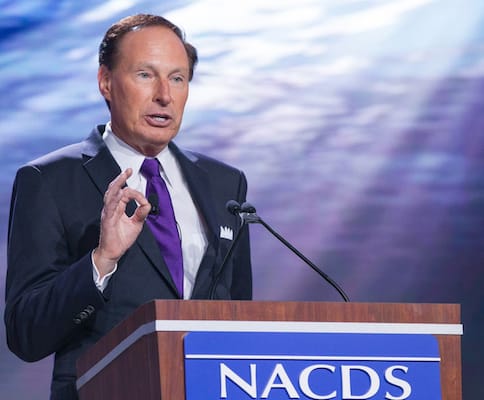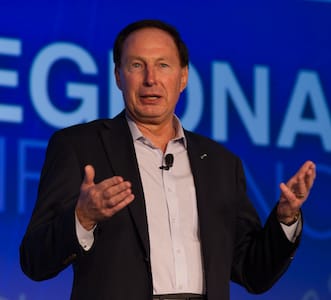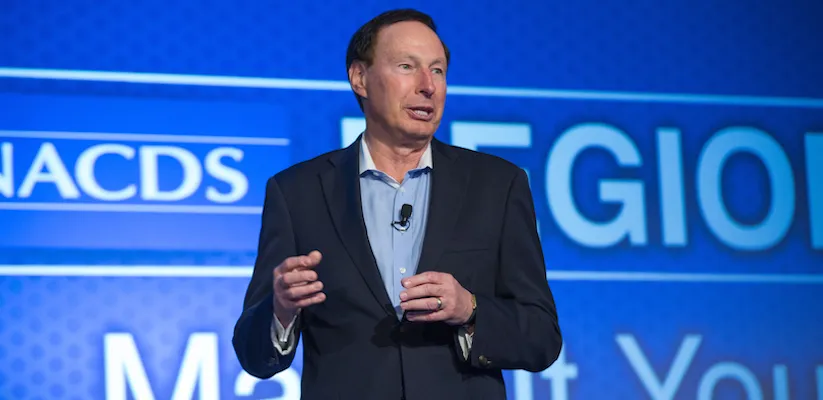
Steve Anderson, NACDS president and CEO
ARLINGTON, Va. — In the nine years since Steve Anderson became chief executive officer of the National Association of Chain Drug Stores, the association has become a proactive advocate for its industry and raised its influence and recognition among legislators and policy makers.
By taking the long view, NACDS has helped the chain drug business prepare for the future. Soon after Anderson took the helm in 2007, it issued “Project Destiny,” a look at how the practice of pharmacy might evolve in a decade’s time. The study turned out to be prescient about medication adherence, medication therapy management and many other issues.
Anderson recently talked with Jeffrey Woldt, vice president and editorial director at Chain Drug Review. Here is an excerpt of their discussion.
CDR: Your strategic plan for the year is a good place to begin. What does it contain?
ANDERSON: We spend a couple months putting it together. While it’s always centered on our three key priorities — government affairs, member services and communications — it changes from year to year, depending on the issues. We knew last year, as an example, that the final rule for AMP [average manufacturer price] was going to come out from CMS [Centers for Medicare and Medicaid Services] in 2016.
I went back as I was putting together the plan for 2016 with the staff, and I noticed that the new AMP final rule would come out 10 years after the Deficit Reduction Act was enacted in 2006. The first AMP rule as a result of that was released right when I came to NACDS.
Also, that’s when we did the Project Destiny study, which [former Kerr Drug chief executive officer] Tony Civello was really passionate about as NACDS chairman. We worked with APhA [the American Pharmacists Association] and NCPA [the National Community Pharmacists Association] on it. It dealt with where we hoped practice models were going to go, where we wanted community pharmacy to be in the future.
Of course, we knew our chain members would follow their own business plans, but Project Destiny was a valuable exercise that got everyone thinking about pharmacy’s future.
It’s interesting how that work has put us in a better position, now, to actually implement those activities that were contained in the original report. NACDS is always looking out even further, toward where we think the industry’s going to be, and what NACDS needs to do in order to lead those efforts.
CDR: What will that work entail?
ANDERSON: We’re going to take a more long-term view. Because of the change in the nature of the industry, we’ve got to make sure that NACDS is continuing to bring value to our members, something that we focus on a lot and which has delivered good results. I think that’s why our membership retention and recruitment are so strong.
CDR: Most everyone would agree on what the objectives are. The questions are who will get there first, and how will they do it.
ANDERSON: It’s a hard job to try to create the right environment and make sure that the companies have the flexibility to pursue their different business plans. It’s becoming a more diverse industry. We have different types of members, and we even have some nonpharmacy people who want to be engaged with NACDS because they like what we do.
CDR: You’re talking about the value NACDS brings to the membership. The AMP issue is a great example.
ANDERSON: We try to quantify all of our policies, so we have a pretty good idea of the dollar amount of what our advocacy efforts produce or block.
It was interesting, because I came in after the Deficit Reduction Act was enacted, and the original AMP rule was being issued. I still like to quote that PwC study that was done at the time that concluded there were about 11,000 pharmacies that could have been forced out of business, which was about 20% of all drug stores. You could see the look of concern in the eyes of NACDS members when the rule was first issued, and it reflected how bad the situation was.
Given the real-world consequences, I think we do add value.
We have monthly meetings with the Executive Committee, so we are remaining in close contact with our leadership. That’s a good example of the value that we can bring to the membership and to ensure we are meeting the needs of the NACDS membership.
CDR: When do you think you will be ready to take a position publicly?
ANDERSON: We’ll put it before the Executive Committee, and we’ll discuss it out at the Board of Directors meeting a month later.
We’re also reaching out to NCPA. We’re also talking to PhRMA [Pharmaceutical Research and Manufacturers of America]. We set up an AMP coalition of interested associations, and we’ve reconvened that group.
The NACDS Policy Council, which reviews all these issues and makes recommendations to the Executive Committee, is very deep into the analysis of the AMP rule. We’re well suited to deal with these kinds of issues because our structure is such that we have a good idea of what our members think, and that really drives our positions.
At the same time, our state relations team is as strong as it’s ever been, building really valuable allies for NACDS, such as the state pharmacists’ associations, the state retail federations and others.

Anderson: “Because of the change in the nature of the industry, we’ve got to make sure that NACDS is continuing to bring value to our members.”
CDR: Do you find NACDS members are becoming more proactive?
ANDERSON: Without a doubt. It’s huge. We’re blessed with that. Having done association work for a long time, I can say I don’t think any association has an impact on their member companies like NACDS does.
Look at what we did with the AMP rule. The need to confront the old AMP rule shows the value of that, and that’s a very significant impact on the membership. So they are highly engaged.
CDR: NACDS has been a strong advocate for MTM and adherence programs.
ANDERSON: Yes. We’re excited about the MTM model that CMS is pursuing through its health care innovation division. They’re accepting applications for people to do pilot programs. That’s going to be really important, and I think that’s a result of us just beating the MTM drum.
We have some great pharmacy champions on Capitol Hill who are encouraging CMS to move forward with that initiative. It is really going to be a good thing that we can at least start to prove the value that MTM can have for patient health.
CDR: Maybe you could talk a little bit about the Affordable Care Act and what it has meant to the community pharmacy industry.
ANDERSON: We have a better viewpoint of what it is now. CBO [the Congressional Budget Office] came out with a number last week saying the ACA was going to cost $189 billion or so less than what they thought it was going to be. At the same time, the enrollment numbers aren’t quite what people thought they were going to be.
But the ACA has given us a good platform to communicate the value of the pharmacy and serve more patients.
On the MTM bill, and on the provider status bill that we’re working on, you have as many Republicans as you have Democrats as cosponsors. If you really want to advance the policy agenda, you need that bipartisan support.
The Affordable Care Act is a massive piece of legislation, and it can be looked at as a whole or broken down into its component parts. We had the AMP provision in there, along with other provisions, but we didn’t take a position on the entire package. I think it has allowed us to communicate the value of what we do.
When we were doing the Project Destiny report a decade ago, we did surveys of people on the Hill, and they never viewed NACDS members as part of the health care delivery system. We were just seen as retailers who sold drugs in addition to other consumer products. Now, they fully understand that we provide health care, and it’s a good place for our members to be.
It’s fascinating to see the opportunities that shift has created, and what our members are doing, in terms of expanded pharmacy services.
CDR: Going back to provider status, what are the prospects of getting legislation enacted this year?
ANDERSON: It’s a short legislative year because of the 2016 elections. So we might have some progress on that, and we could attach it to a bill that is moving. We always look for opportunities like that.
How bills become law isn’t necessarily the way bills become law in the civics class we took in high school. On the MTM bill and on the provider status bill, we have fantastic support.
CDR: Are there state-level issues that are a major concern for NACDS and its members?
ANDERSON: Yes. The biggest one — and we’re very proactive on these issues — is the scope of practice. On a state-by-state basis, NACDS continues to identify opportunities for enacting statutory and regulatory changes to expand pharmacists’ scope of practice.
We’re in a good position on those issues because pharmacy is now speaking with one voice. Today I see the entire industry speaking with one voice. Not just NACDS and NCPA, but other pharmacy organizations, the state associations and our members. By all of us working together, we can drive down health care costs and save lives at the same time with these expanded services that our members perform.
CDR: We’re seeing a lot of consolidation in the pharmacy business. How does that affect the industry, and NACDS’ relationship to the industry? Does it put pressure on you because of fewer potential members?
ANDERSON: I measure the success of NACDS on the basis of our brand, clout and revenue. Our brand and clout have never been stronger in our 83-year history — with our member companies, with lawmakers and regulators, with the media, with other national and state trade associations and professional associations, and with our other target audiences. As a result, the NACDS revenue has never been stronger, and we manage those revenue streams in order to give us the tools to represent and serve the NACDS members.
NACDS has adapted to the multitude of changes that have taken place in our industry since our founding in 1933. And because of our strength of brand, clout and revenue, NACDS has been and continues to be in the strongest possible position to adapt quickly to the dynamic and ever-changing environment in which we find ourselves today.
Over the years, NACDS has expanded our membership with the growing involvement of traditional drug stores, food and grocery, and mass market retailers. Because of this diversity, virtually every consumer product is sold in our member companies’ stores. As a result, NACDS has been able to grow the involvement of our associate supplier members.
Nine years ago, the NACDS Board of Directors decided to take NACDS in a different direction from where it was previously. Because of the bold changes, NACDS can respond to the changes we now see in the industry. We aren’t just adapting to the change, we create the change.
CDR: Pharmacy, in many ways, looks to have a bright future. The demand for more pharmacy service is increasing. At the same time, the industry is facing some tough financial challenges. Is the glass half full or half empty?
ANDERSON: I think it’s 7/8 full. Once again, we can see where the industry is going. We look at it in terms of not just what our members are doing, but what’s happening in society and demographic trends.
Health care is going to be an even larger sector of our economy, and it’s already huge.
So I think the future is incredibly bright. We just need to keep NACDS strong in terms of our brand, clout and revenue, and we need to keep the entire industry united, as we’ve been able to do. I know we’ll be in very good shape for the decades to come.
*Editor’s Note: To read the full interview with Steve Anderson, please see the April 18, 2016, print issue of Chain Drug Review.







